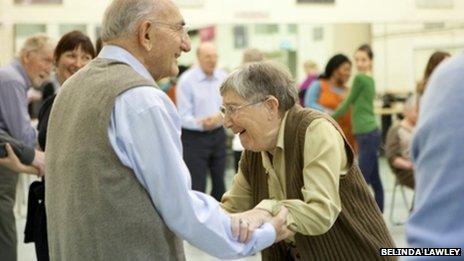En pointe to tackle Parkinson's disease
- Published
Ballet helps tackle Parkinson's disease
When Peter Linton was diagnosed with Parkinson's disease four years ago, his first thought wasn't to take up ballet.
The condition affects Peter's coordination, makes movement slower and less controlled, and gives him difficulties with balance and walking. Ballet, you might think, would be last thing to which he was suited.
But in the rehearsal rooms at the English National Ballet, as the piano thumps out music from the Nutcracker, he lifts his arms ready to dance.
He now he attends weekly ballet classes specifically targeted at people living with Parkinson's to help balance and coordination - and, in the process, he has found a new way to express himself.
"Physical exercises are just that, but music adds a new dimension to what we are doing," he said.
"We're trying to express ourselves, not only in dance but responding to the music. And that I find really quite absorbing."
Finding means of expression is especially important for people living with Parkinson's, because many of their symptoms make communication, both verbal and non-verbal, difficult. Expressive art forms such as dance might offer new hope.
The weekly Dance for Parkinson's classes are being run by the English National Ballet.
"After the class one feels better in several different ways," said Peter.
"First, is the purely physical side - you've had some exercise, sometimes quite vigorous, to loosen the muscles and improve the tone.
"And then comes the music - you've had an hour of very beautiful music, and that adds this emotional dimension. And then are the social things as well - the cup of tea after the class."
Researchers at the University of Roehampton, led by Dr Sara Houston, are measuring the observed changes in patients' physical and emotional well-being.
The study, which will run for two more years, monitors changes in patients' balance and stability, as well as interviewing them about their experiences.
"We are examining the experience that people might have dancing with Parkinson's," Dr Houston told the BBC.
"That experience encompasses changes in physicality, as well as perceptions of what people can do, health and well-being."
Medication limits
There is no cure for Parkinson's, but symptoms can be helped in the short-term by medication.
However, drug treatments become less effective after only a few years, leaving patients to cope as best they can with their worsening symptoms.

It is hoped that benefits seen from the ballet classes will help to slow down the inevitable deterioration faced by patients.
Danielle Jones is the lead dance artist for Dance for Parkinson's. She helped to develop the programme and now teaches the classes.
"It's not like physical therapy, it's about being creative and expressive with movement. We try to improve a feeling of flow, a feeling of grace, and most importantly freedom," she said.
"What I notice in the participants is their confidence to believe in themselves as movers, as dancers - to understand that they are capable of these things.
"So they are able to take risks [in their movements] and do it in a creative and expressive way."
Finding means of expression can be a particular challenge for Parkinson's patients. The disease affects an estimated seven to 10 million people worldwide and research suggests more than three-quarters of patients have difficulties with speech and voice.
"They have difficulty expressing themselves in a number of ways," said Dr Houston.
"Firstly, through speech, which due to Parkinson's often gets slurred or diminishes in loudness.
"And also because of stiffness and slowness of muscles, facial expressions don't work as well so often it's difficult for people with Parkinson's to communicate, and through communication to express themselves."
And the Dance for Parkinson's classes may offer one way for patients to address those difficulties.
Dr Houston's research is revealing just how much dance has to offer above simple exercise and movement.
"People are valuing the dance for its expressive inputs. They perceive it to be something that they can communicate through.
"This extra dimension in dance, which you don't get through other physical activities, the imaginative element, becomes very important to people."
For Peter, who has had a fondness for ballet for more than 40 years, the classes certainly seem to be having positive effects.
"There's no doubt in my mind that doing more exercise does improve the symptoms.
"They'll never get better but at least they won't get worse. And some people tell me that I now look and behave better than I did three years ago."